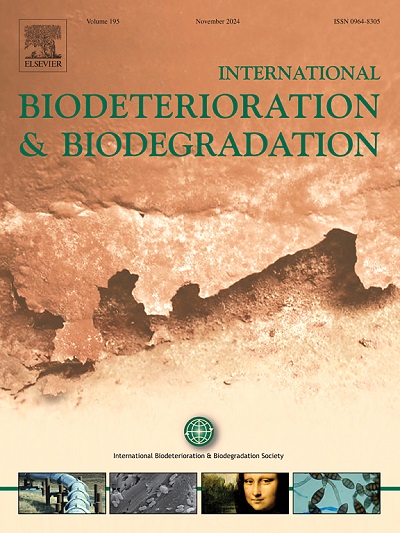Temperature-driven alterations in bacterial community responses to decabromodiphenyl ether (BDE-209) contamination in soil microcosms
IF 4.1
2区 环境科学与生态学
Q2 BIOTECHNOLOGY & APPLIED MICROBIOLOGY
International Biodeterioration & Biodegradation
Pub Date : 2025-03-31
DOI:10.1016/j.ibiod.2025.106078
引用次数: 0
Abstract
Polybrominated diphenyl ethers (PBDEs) are organic pollutants that pose a threat to natural environments, and their sensitivity can be influenced by various factors, including temperature in real-world environment. Achieving an understanding of how microorganisms respond to PBDEs at various temperatures is crucial for assessing ecological risks or identifying potential degraders. For this study, microcosms were established with or without the addition of 10 mg kg−1 decabromodiphenyl ether (BDE-209) and then incubated at four temperatures—4 °C, 15 °C, 25 °C, and 37 °C—for a period of 180 days. The results indicated that BDE-209 debromination rates decreased in the following sequence: 15 °C, 25 °C, 37 °C, 4 °C. Temperature made a vital role in the diversity, composition, and potential degrading bacteria of BDE-209 debromination. When incubated at 4 °C, 15 °C and 25 °C, BDE-209 substantially reduced the network complexity, highlighting the PBDEs-associated risks in low and moderate temperature microcosms. In contrast, the incorporation of BDE-209 was beneficial for community characterization and networking at 37 °C. The Random forest model pinpointed specific taxa that could potentially be associated with PBDEs debromination at various incubation temperatures. These results revealed contrasting effects of PBDEs on bacterial communities at various temperatures, thus attention should be paid to the impact of PBDEs on soil ecology in real environmental conditions.

土壤微生物中细菌群落对十溴联苯醚(BDE-209)污染响应的温度驱动变化
多溴联苯醚(PBDEs)是一种对自然环境构成威胁的有机污染物,其敏感性受到多种因素的影响,包括现实环境中的温度。了解微生物在不同温度下对多溴二苯醚的反应,对于评估生态风险或识别潜在的降解物至关重要。在本研究中,在添加或不添加10 mg kg−1十溴联苯醚(BDE-209)的情况下建立微环境,然后在4°C、15°C、25°C和37°C四种温度下孵育180天。结果表明,BDE-209的脱溴率在15°C、25°C、37°C、4°C时依次降低。温度对BDE-209脱溴的多样性、组成和潜在降解菌的组成起着至关重要的作用。当在4°C、15°C和25°C孵生时,BDE-209显著降低了网络复杂性,突出了在低温和中温微观环境中与多溴代醚相关的风险。相比之下,加入BDE-209有利于在37°C下进行群落表征和建立网络。随机森林模型确定了在不同孵育温度下可能与多溴二苯醚脱溴有关的特定分类群。这些结果揭示了不同温度下多溴二苯醚对细菌群落的影响,因此在实际环境条件下,多溴二苯醚对土壤生态的影响值得关注。
本文章由计算机程序翻译,如有差异,请以英文原文为准。
求助全文
约1分钟内获得全文
求助全文
来源期刊
CiteScore
9.60
自引率
10.40%
发文量
107
审稿时长
21 days
期刊介绍:
International Biodeterioration and Biodegradation publishes original research papers and reviews on the biological causes of deterioration or degradation.

 求助内容:
求助内容: 应助结果提醒方式:
应助结果提醒方式:


